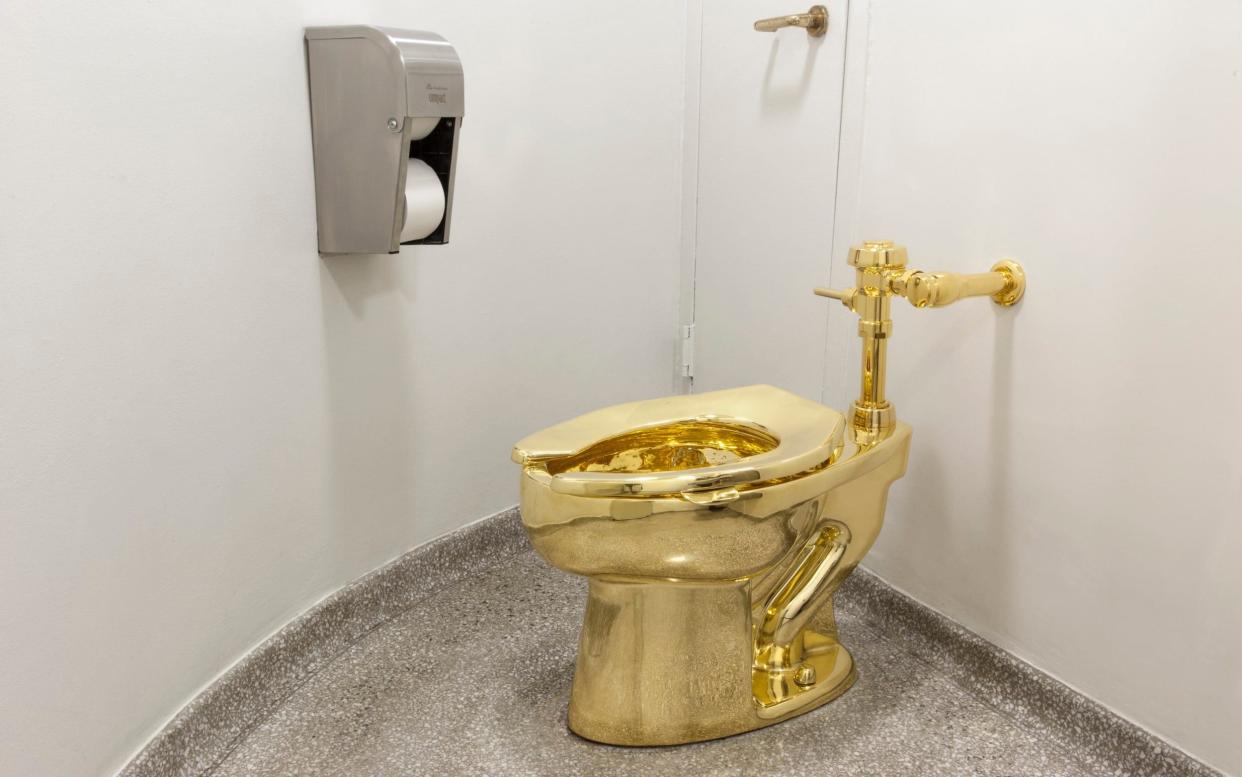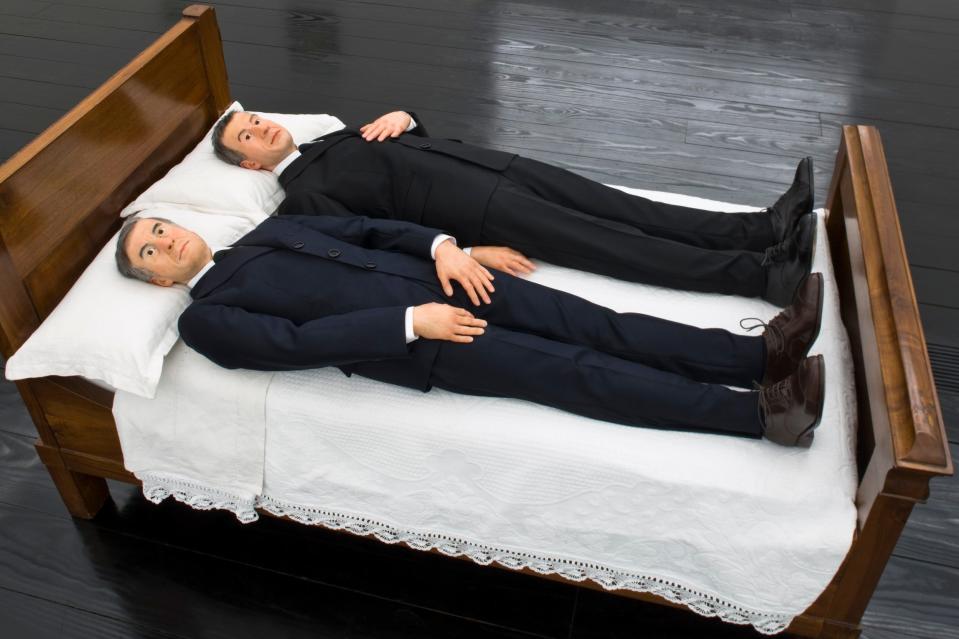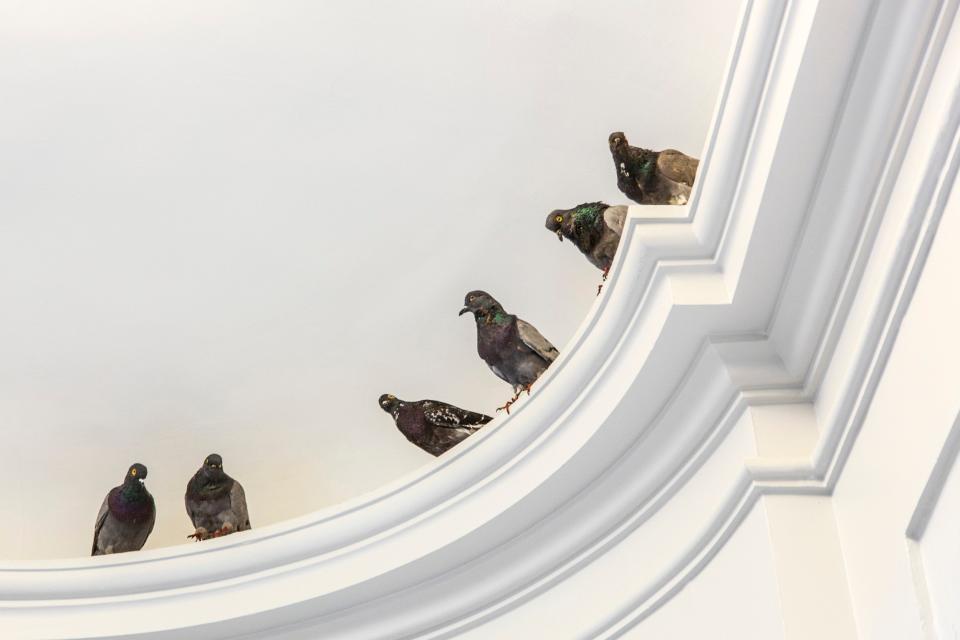Maurizio Cattelan review, Blenheim Palace: just a prankster with a gold toilet? Think again

- Oops!Something went wrong.Please try again later.
Early autumn at Blenheim Palace, and soft evening sunlight is illuminating the Long Library. At the far end, a dark-haired schoolboy, wearing a tweed uniform, kneels before an an organ. Who is this silent young fellow, seemingly lost in prayer?
Walk past him, and you get a shock. For this “child” has an extreme side parting and a distinctive toothbrush moustache. It turns out that he’s Hitler – or, at least, a pint-sized waxwork effigy of the Nazi leader – praying, one dreads to think, for what?
This is “Him” (2001), a notorious sculpture by the Italian conceptual artist Maurizio Cattelan, the subject of the sixth exhibition staged by Blenheim Art Foundation.
Cattelan is invariably described as a “prankster”, the class clown of contemporary art – and, it’s true, much of his work adopts the guise of a provocative gag.
A painted replica of Walt Disney’s Pinocchio, visible through the Long Library’s windows, floats face down in a pond, as though the poor puppet has drowned. “Daddy, Daddy”, the piece is called, but where was Geppetto when his wooden boy needed him?
Yet, if “Him” is a joke, it seems like an irredeemably sick one. So does its price tag. Three years ago, a version sold at auction for $17.2 million.
Until now, I’ve been sceptical of Blenheim Art Foundation. Established by Lord Edward Spencer-Churchill, brother of the current, 12thDuke of Marlborough, it struck me as either an aristocratic amusement or a cynical business move, designed to lure new audiences to a national monument. Or both.
There have been strong moments – Jenny Holzer’s brooding, anti-war installation two years ago springs to mind – but last year’s exhibition, which sprinkled small sculptures by the post-war French artist Yves Klein around the palace like so many decorative baubles and trinkets, felt especially tame.
Yet, this year’s show – Cattelan’s first solo exhibition in Britain for 20 years – is a success.
It works because it suggests that Cattelan isn’t, in fact, an asinine jester, unleashing one-liners to elicit cheap laughs, but an artist with a much deeper, defter mind than has hitherto has been recognised.
Certainly, he has thought extremely carefully about the placement of the 20 or so works in this exhibition – including six new pieces, such as the taxidermy crocodile that hangs from the ceiling of one state room. Throughout, his sculptures interact – mischievously and ingeniously – with their surroundings.

Consider “Him”, which flashes with added provocation once you realise it’s on display in the birthplace of Hitler’s antagonist, Churchill. Supposedly, had Hitler won the Battle of Britain, Blenheim would have been his official residence. He might have prayed in the Long Library for real.
Elsewhere, we encounter another of Cattelan’s greatest hits, “La Nona Ora” (1999), a waxwork of Pope John Paul II struck down by a meteorite.
The sculptureThis sculpture is often interpreted as a savage takedown of the Catholic Church.
In this massive country house, though, built, in the English Baroque style, to commemorate the 1stDuke of Marlborough’s military victories over those dastardly Catholics, the French, it acquires added piquancy. Craftily, Cattelan positions “La Nona Ora” beneath a portrait of the Sun King Louis XIV, the Duke’s foe.
A lot of Cattelan’s art interrogates military power and jingoistic sentiment (hence, I suppose, the exhibition’s title, “Victory is Not an Option”), at a time when, worryingly, far-right movements are gaining support across Europe.
Inside the Great Hall, for instance, we find a monumental replica of the flag-bearing arm of a 19th-century French equestrian statue of Joan of Arc, in part inspired by military banners found elsewhere in the palace. Every May Day, France’s National Front holds a ceremony in front of the original sculpture in Paris. “Reality is far more provocative than my art,” Cattelan says.
Wealth is another target. In Blenheim’s faded and peeling chapel (which, frankly, could do with some TLC), the figure of a sleeping, huddled tramp occupies a pew. Are those cobwebs nearby real, or set-dressing by the artist?
Meanwhile, in a closet beside the bedroom where Churchill was born, Cattelan has installed “America” (2016), a solid-gold, fully functioning toilet, which visitors may use, so long as they book a timeslot.
Reader, it would be indelicate to reveal whether this reviewer sought relief, but I will say this: I wish Cattelan’s golden loo had been plumbed in ahead of last year’s visit of Donald Trump, whom this satirical work, in part, excoriates.
On a superficial level, this exhibition is darkly entertaining. No doubt, many visitors will simply snigger, and then leave. Ha, ha. Switch off.
Usually, though, there are tears behind a clown’s smile, and so it proves with Cattelan, whose subversive ideas are troubling and thought-provoking, as well as funny. He is at his wittiest when most deadly serious.

A self-portrait, in the form of a caricature-like effigy, hangs in the Green Drawing Room, alongside portraits of the Duke’s ancestors. Cattelan looks mischievous but also awkward, dangling from a hook. Perhaps he’s conflicted over his relationship with his patrons. Can court jesters truly influence the powerful they entertain?
He should relax – because, at Blenheim, Cattelan fits right in. On my way out, I passed several 18th-century chairs specially upholstered with a red-patterned fabric featuring the face of Louis XIV, artfully positioned so that visitors would sit on the defeated Sun King’s face.
It’s exactly the sort of prank that Cattelan would have come up with, if only the first duchess hadn’t done so already.
From today until Oct 27; information: 01993 810530 blenheimartfoundation.org.uk/exhibitions

